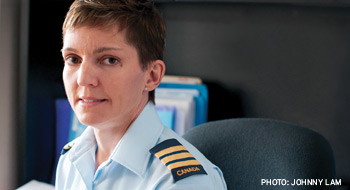

The physical dangers associated with a career in the Canadian Forces are readily apparent. Less obvious, perhaps, is the mental strain faced by military personnel deployed overseas. Stress triggers are a daily reality for soldiers in combat situations, and the ability to deal with stress can mean the difference between life and death.
“Obviously, we can’t turn off the fear. So we teach them how to manage the stress response in unpredictable situations so they can continue to perform the job they’re there to perform,” says Lieutenant-Colonel Suzanne Bailey, a 25-year veteran of the Canadian Forces who began as a military police officer before completing the training to be a social work officer.
Bailey says that while the Canadian Forces has offered its personnel a suite of mental health-related programs for many years, it wasn’t until she joined the organization’s Health Services Group in 2008 that staff realized there was no standardized national initiative aimed at preparing military personnel for deployment. This was the impetus behind the creation of The Road to Mental Readiness, launched at the end of 2009.
The program includes both troops and their family members in pre- and post-deployment training phases. Bailey says providing both groups with the same skills, and using the same military-specific language, ensures that troops and their families can communicate before and after deployment in the same way.
“We’ve had the military family resource centres giving information and educational sessions for a number of years,” Bailey explains. “But I think this is the first time we’ve all sat at the same table and ensured that the language, skills and information we’re giving is consistent for both family members and military members.”
The Road to Mental Readiness has six phases. In phase 1, participating military members spend eight hours in a classroom environment learning about how the brain reacts to stress and fear and examining skills that can be used to mitigate fear in battle situations. Phase 2 focuses on the practical application of these skills. Phase 3 invites military family members to learn many of the same skills and educates them on how to apply these skills to their own related fears and stresses. Phases 4 and 5 are centred around recognizing and coping with issues that troops will deal with after returning from combat and reintegrating into their home life and community. While phase 4 is directed at soldiers, Bailey notes that phase 5, the family component, is equally important. Phase 6 involves post-deployment screening between the three and six months following reintegration. Personnel are screened for depression, thoughts of suicide, signs of post-traumatic stress disorder and alcohol dependency.
Bailey explains that the biggest challenge associated with the program is simply delivering it: for each overseas mission, combat or humanitarian, she estimates that about 2,600 soldiers need to go through the program. To facilitate this, a “train-the-trainer” format is used, in which uniformed officers partner with mental health clinicians in week-long training sessions to allow them to jointly deliver the program material to deploying troops.
“They have to achieve a certain level of proficiency in order to present it, but they also have to have the desire. We’ve had a couple of guys say, ‘I think this is a great package and I’m happy to participate, but I’m not comfortable standing at the front of the class and teaching about mental health.’ And we respect that. It’s not for everybody to get up and teach this.”
Bailey estimates that 90% of the officers who’ve undergone the training have gone on to deliver the program. “These operators have the credibility, they speak the same language and use their own operational examples, and they know the guys in the audiences that they’re teaching this to. So it tends to work very well.”
Another challenge is determining how to measure program results. When they start the in-class phase of the program, personnel answer a questionnaire designed to measure their attitudes toward, and knowledge of, mental health issues. After the session, they’re given the same questionnaire to determine if there are changes in their attitudes and knowledge.
Bailey adds that her team is working on a strategy to measure long-term results, to determine if personnel who go through the training are able to effectively use the skills taught during deployment and also after returning home.
But putting programs in place aimed at teaching personnel and their families how to identify and manage mental stress is only the first step, Bailey stresses. More important is helping them understand that these skills need to be continually honed.
“This type of training is like wearing a flak jacket: it provides some protection if you use it the way it’s meant to be used. We let people know that if they don’t practise these skills in their day-to-day life, when things happen in an unpredictable situation, these skills are not going to work.”
Neil Faba is associate editor of Benefits Canada. neil.faba@rci.rogers.com
Get a PDF of this article.
